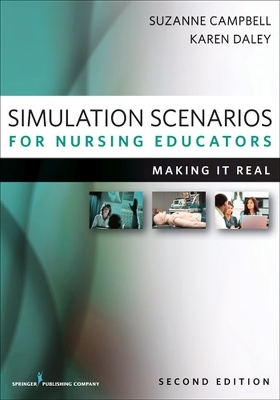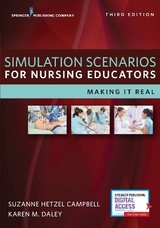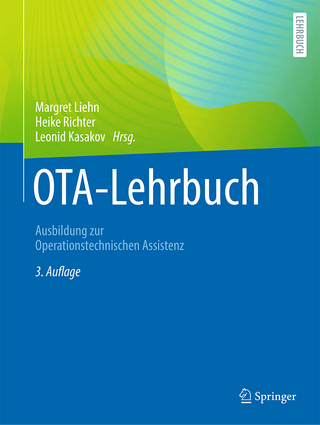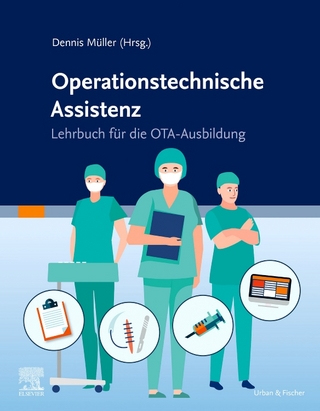
Simulation Scenarios for Nursing Educators
Springer Publishing Co Inc (Verlag)
978-0-8261-9326-1 (ISBN)
- Titel ist leider vergriffen;
keine Neuauflage - Artikel merken
The authors provide concrete information about the use of simulation in a variety of programs, courses, and schools and include real life scenarios of how nursing faculty have mastered the challenge of integrating simulation into their curriculums. The book provides recommendations on integrating point of care decision-making tools, necessary equipment, how to set up a lab (including static to high fidelity mannequins), scenario running instructions, and much more. The text also includes an enhanced eBook guide. This updated edition includes:
Scenarios that are easily adaptable to instructor's own lab
New scenarios for specialty undergraduate nursing and advanced practice nursing
New interdisciplinary, interprofessional, and community-based scenarios
Twenty new chapters
Expanded chapter templates
A complete reorganization for clarity of content
A focus on cultural sensitivity and health literacy
Research methods and international research
Future development including certification and integrating e-records in simulation
Faculty development
Key Features:
Integrates patient simulations into nursing curriculum, from undergraduate to graduate levels and in discipline-specific contexts
Includes recommendations on integrating point of care decision-making technology
Addresses a wide range of clinical situations
Presents conceptual foundations for simulation in nursing education
Offers enhanced eBook guide
Suzanne Hetzel Campbell, PhD, APRN-C, IBCLC, is Associate Dean for Graduate Academic Programs and Associate Professor, Fairfield University School of Nursing. She specializes in women's health issues and the interface between nursing education and technology (specifically in online learning and simulation laboratories). She is an International Board Certified Lactation Consultant, a Woman's Health Care Nurse Practitioner, and a member of Sigma Theta Tau. In 2006, she managed the successful application of an HRSA grant for the School of Nursing, gaining nearly $468,000 over three years to help in evaluating simulation activities and directing School of Nursing learning resource center. She is a frequent author in peer-reviewed journals and in nursing education books. |Karen M. Daley, PhD, RN graduated fromVillanova University with her BSN, from Troy State University with aMS in Nursing, and a PhD in Nursing from Rutgers, the State University of NewJersey. Presently, she is Associate Professor and Graduate Nursing Coordinator for the Department of Nursing atWestern Connecticut State University. Her academic interests currently involve assessment of outcomes in nursing programs through standardized testing, fostering collegiality and caring between faculty and students, and integrating simulation in nursing education. AtWestern Connecticut State University, Karen has spearheaded the implementation of human patient simulation throughout the curriculum and is primarily responsible for the acquisition of SimMan technology, the expansion and development of the Nursing Labs and the Nursing Resource Center, and the upgrade of resources for the Nursing Labs.As the chair of the Learning Resources Committee, Karenwas able to acquire additional lab space for an additional SimMan Lab, an Assessment Lab, a technology classroom, and a Ped/OB area.AnewICU lab opened in the fall of 2008 funded by a federal nursing initiative. Karen continues towork to upgrade and integrate simulation into the nursing curriculum, train faculty in simulation-focused learning experiences in their classes, and encourage the use of simulation
Preface
Part I - Setting the Foundation for Simulation
Chapter 1: Introduction - Simulation focused pedagogy for nursing education
Chapter 2: Integrating Simulation-focused Pedagogy into Curriculum
Chapter 3: Enhancing Communication Skills through Simulations
Chapter 4: Faculty Learning Communities: An innovative Approach to Faculty Development
Chapter 5: Building and Maintaining A Learning Resource Center
Part II - Innovative Simulation Scenarios in Diverse Settings for Diverse Students
Chapter 6: Tune into Simulation through Physical Examination
Chapter 7: Care of the Post-Surgical Appendectomy Patient in Pain
Chapter 8: Medical Surgical Skill Based Scenarios
Chapter 8: Trauma Resuscitation
Chapter 10: Code Simulation for Student Nurses
Chapter 11: Obstetric Emergency: Post-partum Hemorrhage
Chapter 12: Obstetric Labor and Delivery Emergency
Chapter 13: Care of the Infant with Congenital Heart Disease Status Post Cardiac Surgical Repair
Chapter 14: Non-Traumatic Head Injury - Infant
Chapter 15: Bacterial Meningitis in a Pediatric Patient
Chapter 16: Pediatric Emergency
Chapter 17: Post-Traumatic Stress Disorder/Traumatic Brain Injury and other conditions in an Iraqi Veteran of War
Chapter 18: Assessing a Patient with a Mood Disorder
Chapter 19: Wound Management in Home Health Care
Chapter 20: Diabetic Home Care Patient with Elevated Blood Sugars
Chapter 21 Home Care Scenario -Elevated Blood Sugar Emergency
Chapter 22: Care of an Older Adult with Congestive Heart Failure
Chapter 23: The Older Adult in an ICU with Acute Respiratory Failure
Chapter 24: Communication with an Elderly Client
Chapter 25 - QSEN: Knowledge, Skills and Values for Nurses
Chapter 26: Innovative Simulation Scenarios in Diverse Settings for Diverse Students
Chapter 27 - Pediatric Palliative Care
Chapter 28: OSCE for NP's
Chapter 29: PsychMentalHealth
Chapter 30: Women's Health NP/CNM
Chapter 32: FNP - GI with Colon Cancer
Chapter 33: Improving Patient Safety through Student Nurse-Resident Team Training: The Central Venous Catheterization Pilot Project
Chapter 34: Interdisciplinary Care of a Cardiac Infant
Chapter 35; Emergency Delivery - Shoulder Dystocia/Abruptio Placenta
Chapter 36: Fire Safety in the OR
Chapter 37 Postpartum Hemorrhage
Chapter 38: Undergraduate Senior Capstone Scenarios: Pearls, Pitfalls and Politics
Chapter 39: Student Generated Scenarios for Senior Simulation Day
Part III The Simulation Journey Continues
Chapter 40: Cutting Edge Visions of the Future of Simulations
Chapter 41: Framework for Simulation Learning in Nursing Education
Chapter 42: Simulation Certification -
Chapter 43: Publishing Your Simulation Research
Chapter 44: Electronic health records
Chapter 45: Faculty Development
Chapter 42: Final Words of Wisdom on Simulation
| Verlagsort | New York |
|---|---|
| Sprache | englisch |
| Gewicht | 456 g |
| Themenwelt | Medizin / Pharmazie ► Pflege ► Ausbildung / Prüfung |
| Pflege ► Fachpflege ► Chirurgie / OP-Pflege / Orthopädie | |
| Studium ► 2. Studienabschnitt (Klinik) ► Anamnese / Körperliche Untersuchung | |
| ISBN-10 | 0-8261-9326-9 / 0826193269 |
| ISBN-13 | 978-0-8261-9326-1 / 9780826193261 |
| Zustand | Neuware |
| Informationen gemäß Produktsicherheitsverordnung (GPSR) | |
| Haben Sie eine Frage zum Produkt? |
aus dem Bereich



